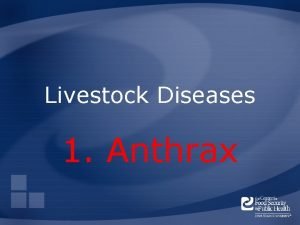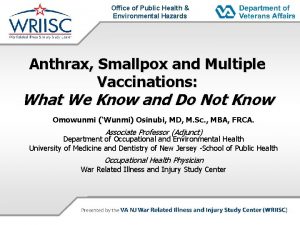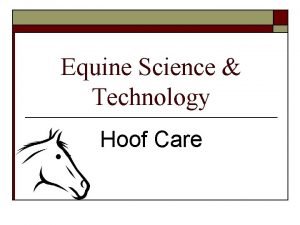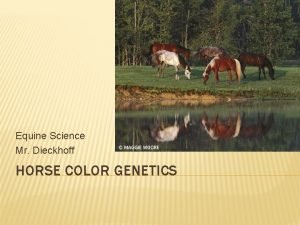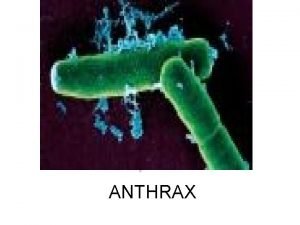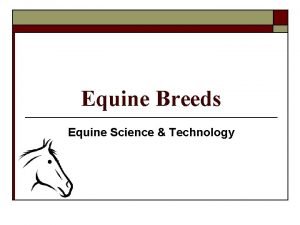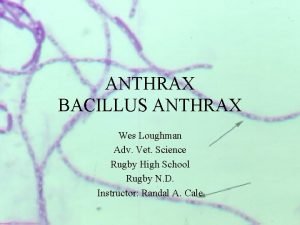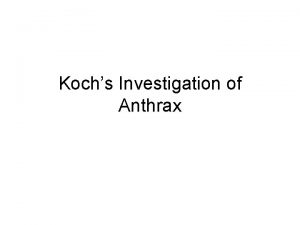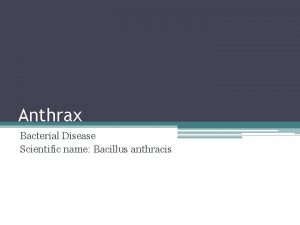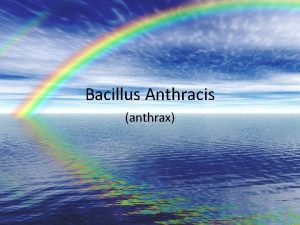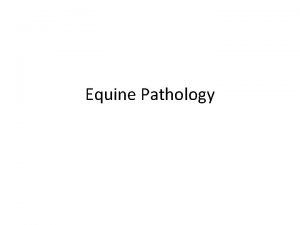Equine Science Technology Equine Diseases Equine Diseases Anthrax




















- Slides: 20

Equine Science & Technology Equine Diseases

Equine Diseases Anthrax (Splenic Fever) Anthrax- an acute infectious disease affecting horses and other warm-blooded animals. Ø Horses usually contract the disease by ingestion of the soil, vegetation, or water contaminated with bacterial spores. Ø Identified by a microscopic examination of the blood, in which will be found Bacilli anthracis.

Equine Diseases Anthrax (Splenic Fever) Ø The first indication of the disease may be the presence of severe symptoms of colic, accompanied by high temperature, loss of appetite, muscular weakness, depression, etc. Ø Disease can be prevented by immunization.

Equine Diseases Diarrhea in Foals Diarrhea is one of the most common disorders in foals. Ø Can be caused by: mare’s first heat after foaling, dietary changes, parasites, and infectious agents, such as bacteria or viruses. Ø The symptoms and signs of foal diarrhea are depression, diarrhea, and loss of appetite.

Equine Diseases Diarrhea in Foals Ø In severe diarrhea, the foal may have fever and reddened mucous membranes. Ø Diarrhea can most effectively be treated if discovered early.

Equine Diseases Equine Influenza Ø A highly contagious respiratory disease widespread throughout the world. Ø Caused by a group of viruses. Ø Outbreaks frequently appear where a number of horses are assembled.

Equine Diseases Equine Influenza Ø Virus itself is carried in contaminated water and on contaminated feed, bedding, buckets, brooms, clothing, etc. Ø Treatment should be handled by the veterinarian and consists of isolation of affected animals.

Equine Diseases Lyme Disease Ø Spread by ticks. Ø Most common symptoms in horses are shifting-leg lameness, fever, muscle aches and pains, limb swelling, eye inflammation, and abortion. Ø Many horses may be exposed to the agent without developing clinical disease.

Equine Diseases Lyme Disease Ø Lyme disease is fairly simple to treat using Penicillin and tetracycline.

Equine Diseases West Nile Virus Ø Virus is spread and carried by mosquitoes. Ø One of the newest diseases to affect horses in the U. S. Ø There is no specific treatment for the disease; treatment is based on presenting signs. Ø A vaccine for West Nile Virus is available, but its effectiveness is unknown.

Equine Diseases Rabies Ø An acute infectious disease of horses and all other warm-blooded animals. Ø Characterized by deranged consciousness and paralysis. Ø Caused by a virus that is usually carried into a bite wound by infected saliva. Ø Treatment is not advisable as infected animals eventually die.

Equine Diseases Equine Infectious Anemia (Swamp Fever) Ø A serious viral disease sometimes referred to as swamp fever, mountain fever, slow fever or malarial fever. Ø Once infected virus remains in the blood for life. Ø Virus is spread by biting insects, especially flies, but may also be spread by hypodermic needles.

Equine Diseases Equine Infectious Anemia (Swamp Fever) Ø Symptoms include: high and intermittent fever, depression, stiffness and weakness, loss of weight, anemia, etc. Ø Treatment has been unsuccessful because there is no method known to destroy the virus in the bloodstream.

Equine Diseases Body Temperature Ø Normally ranging from 100 to 102°F. Ø Body temperature is affected by stable or outside temperature, exercise, excitement, age, feed, etc. Ø Temperature is measured by inserting thermometer into the rectum.

Equine Diseases Pulse Rate Ø Indicates the rapidity of the heart action. Ø Pulse is taken either at the margin of the jaw, at the inside of the elbow, or under the tail. Ø Pulse rate can increase with exercise, excitement, digestion, and high outside temperatures.

Equine Diseases Respiration Rate Ø Determined by placing the hand on the flank, by observing the rise and fall of the flank, or, in the winter, by watching the breath condensate coming from the nostrils. Ø Rapid breathing due to recent exercise, excitement, hot weather, or poorly ventilated buildings should not be confused with disease. Ø In foals the normal respiratory rate may approach 40 breaths per minute.

Equine Diseases Immune reactions are characterized by the ability of the horse to resist and/or overcome disease through either (1) natural immunity or (2) acquired immunity. Natural Immunity Ø First line of defense. However, it is nonspecific. The immune cells attack any bacteria they are not programmed for a specific organism.

Equine Diseases Acquired Immunity Ø Immunity that is specific for a certain organism. Ø Can be either active or passive.

Equine Diseases Acquired Immunity Ø Active Immunity-immunity that results from the immune system being stimulated to produce antibodies. Ø Active immunity is not developed until after one or two weeks, but is far more lasting. Ø If animal is injected with antibodies produced by another individual, the immunity is referred to as passive immunity.

Equine Diseases Acquired Immunity Ø Young suckling mammals obtain passive immunity from the colostrum that they obtain from their mothers following birth. Ø Passive immunity confers immunity upon injection, but the immunity disappears quickly, usually within three to six weeks.
 Marty soehnlen
Marty soehnlen Anthrax history
Anthrax history Jennifer jolivet
Jennifer jolivet Anthrax powder mail
Anthrax powder mail Agedema
Agedema Anthrax
Anthrax Anthrax toxin mechanism of action
Anthrax toxin mechanism of action Anthrax
Anthrax Equine science
Equine science Equine science
Equine science K5 think central
K5 think central Favourite subject science
Favourite subject science Exclusively equine veterinary services
Exclusively equine veterinary services Lingfield vets
Lingfield vets Equine definition
Equine definition Uspc stall card
Uspc stall card Equine encephalitis
Equine encephalitis Equine encephalitis
Equine encephalitis Pasture pals equine rescue
Pasture pals equine rescue Equine synonym
Equine synonym Horse color calculator
Horse color calculator

